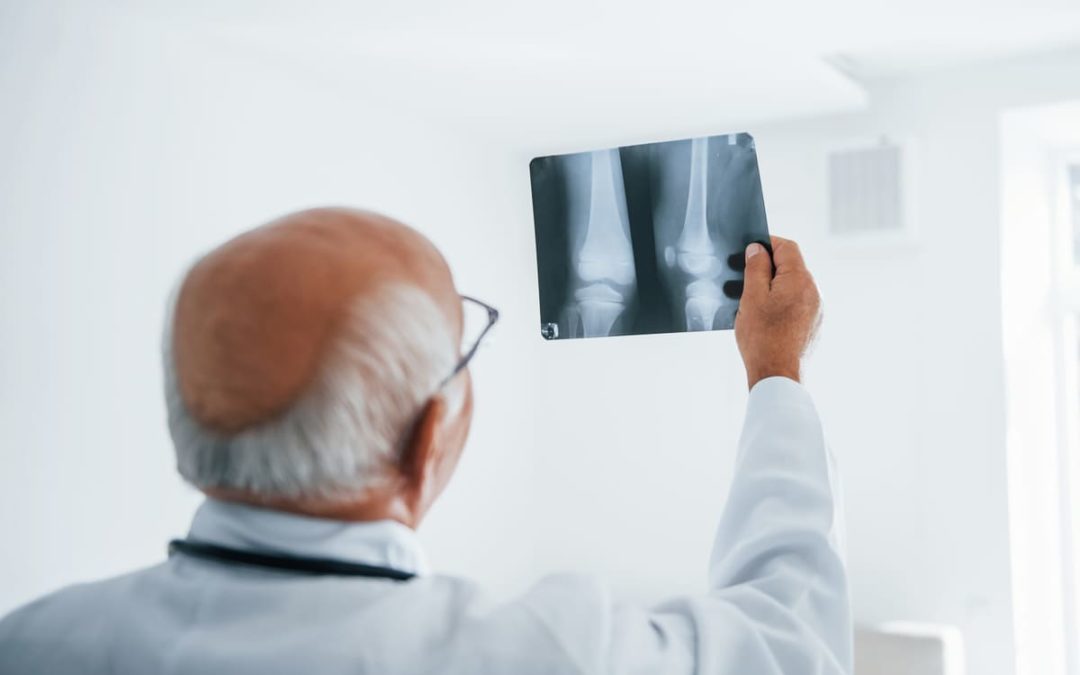Osteopenia is defined as a condition of decreased bone density caused by greater bone loss (resorption) than bone creation. This is considered a milder form of bone loss that does not meet the criteria of osteoporosis.
Osteoporosis is a disease in which bone is lost faster than the body can replace it. This causes bones to become brittle and more susceptible to fracture. It is more common in women but occurs in men as well. Osteoporosis is a disease of bone that leads to an increased risk of fracture. In osteoporosis the bone mineral density(BMD) is reduced, bone microarchitecture is disrupted, and the amount and variety of proteins in bone is altered. Osteoporosis is defined by the World Health Organization in women, as a bone mineral density 2.5 standard deviations below peak bone mass (20-year-old healthy female average). The term “established osteoporosis” includes the presence of a fracture. Osteoporosis is most common in women after menopause, when it is called postmenopausal osteoporosis. It may occur in anyone in the presence of particular hormonal disorders and other chronic diseases or as a result of medications, specifically glucocorticoids. Given its influence is the risk of fragility fracture, osteoporosis may significantly affect life expectancy and quality of life.
Forty to fifty percent of American women will suffer an osteoporosis related fracture of the hip, spine or forearm during their lifetime. Fifteen to twenty million people are currently affected. Bone mass peaks at 20-30 years. Bones are not static, dead tissue that you see in the skeletal remains of an animal. The tissue is alive and very active. Larger, ling bones are completely replaced every 10-12 years, smaller bones (spine) turn over every 2-3 years.
Everyone knows that calcium helps make strong bones. What most people don’t know is that without adequate magnesium, potassium, silica, boron, manganese, copper, zinc and Vitamins C, D and K, optimal bone is not formed. Equally important are the hormones testosterone and progesterone which help build bone, and estrogen which slows bone loss.
Some of the things that can cause bone loss are: low intake of the minerals listed above. Given the average diet of Americans, it is doubtful that the vast majority of people get the necessary amounts without supplementing. Magnesium deficiency is more common in women with osteoporosis than calcium deficiency. Lack of exposure to sun has created an epidemic of Vitamin D deficiency. Many people lack stomach acid (hypochlorhydria). Without adequate stomach acid, minerals cannot be separated from food, digested, absorbed and assimilated. Long term use of antacids and acid blockers can lead to bone loss. Soda pop contains high levels of phosphorus as do fast and junk foods and refined carbohydrates. Too much phosphorus causes loss of calcium and magnesium in the stool and urine, leading to bone loss.
Other things that accelerate bone loss are: coffee, alcohol, smoking (bone mineral content of smokers is 15-30% lower than non-smokers), aluminum, diuretics (which increase loss of calcium, magnesium and potassium in the urine), fluoride (drinking fluoridated water can increase the risk of hip fractures by 20-40%), and long-term use of corticosteroids (Prednisone).
Some of the early signs of osteoporosis are: sudden onset of insomnia and restless legs, night cramps, persistent low back pain, sudden, severe low back pain, loose teeth and gradual loss of height. You are at higher risk if you: are a woman, Caucasian, are post-menopausal, have had a complete hysterectomy, have suffered from chronic PMS, have had children, have a family history of osteoporosis, are thin and short, have a poor diet, don’t exercise, smoke, drink more than two alcoholic drinks or coffee per day, drink soda, take Prednisone or anti-convulsant drugs, are hyper or hypo-thyroid, eat a lot of protein or use antacids or acid blockers regularly. If several of the above apply, I suggest you get checked.
The best way to check your bone density is a test called Dual-Photon Absorptiometry or one called Dual Energy X-ray Absorptiometry, called a DEXA scan. Ask for one from your doctor. The best medicine is prevention. If you have osteopenia, you can slow, halt or reverse it if you stop the wrong things and do the right ones. In my opinion, that does not include taking Fosamax, which does not create new bone that is structurally sound. Bone loss has numerous causes. Treating with a drug that does not address the multiple underlying causes is doomed to failure.
About the Author: Dr. Douglas L. Weed
Dr. Weed practices Functional Nutrition, Chiropractic care, and offers weight loss solutions in Napa, CA at Heun Chiropractic, Inc. He has a doctorate in Chiropractic care and he has received certifications in physical rehabilitation and as a Qualified Medical Examiner. With a post-graduate certification in Functional Medicine, focusing on functional endocrinology, digestive disorders and Peripheral Neuropathy, he is committed to lifelong education and helping patience transform their health.

